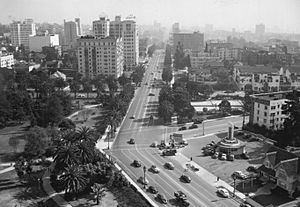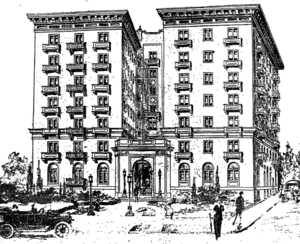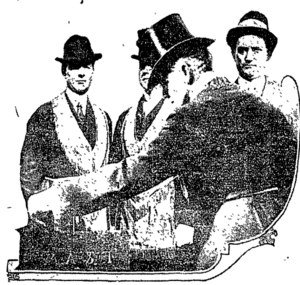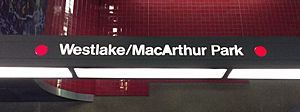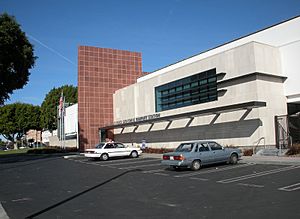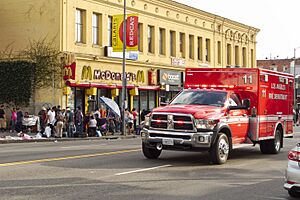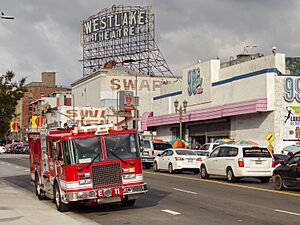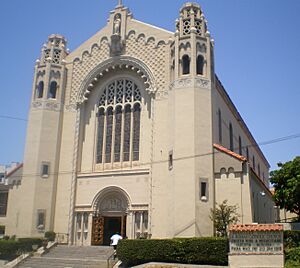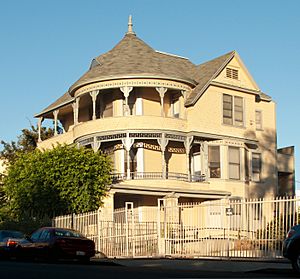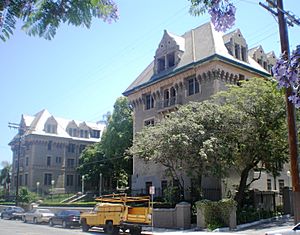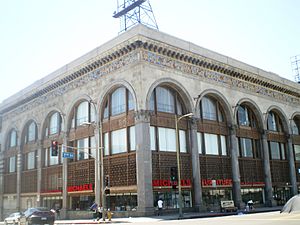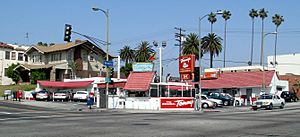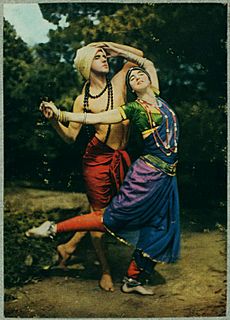Westlake, Los Angeles facts for kids
Quick facts for kids
Westlake
|
|
|---|---|
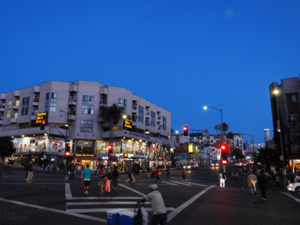
Intersection of 6th and Alvarado streets in the neighborhood, 2018
|
|
| Country | United States |
| State | California |
| County | Los Angeles |
| Time zone | Pacific |
| Zip Code |
90017, 90012, 90026, 90057
|
| Area code(s) | 213 |
Westlake, also called the Westlake District, is a lively neighborhood in the heart of Central Los Angeles, California. It's a busy place with homes and businesses. This area grew a lot in the 1920s. Many beautiful old houses have become apartments, and new apartment buildings have been built. Westlake is known for having many people living close together. It has a young population, and many residents are from Latino backgrounds. You'll find many schools here for kids of all ages.
Contents
Westlake's Story: A Look Back in Time
How Westlake Began
In 1887, people called Westlake the "southwest quarter" of Los Angeles. The hills of Westlake already had many nice homes. It was clear that this area was just starting to grow. Many land plots in the area were quickly sold. Their prices also went up. A new Baptist College was also being built to the north.
The neighborhood got its name from Westlake Park. The land for the park was given by Henricus Wallace Westlake. He was a doctor from Canada who moved to Los Angeles around 1888. He built his home on Burlington Avenue. This was the first house in the rolling hills west of the main town.
Westlake was one of the first areas west of Figueroa Street to have homes. It became home to many Jewish families. Rich business people traveled from Westlake to downtown and other areas. They lived in beautiful homes built in the Spanish Revival and Art Deco styles. Around the 1940s, some of Los Angeles's early working-class Filipino people moved to the northwestern parts of Westlake. They had moved from other areas like Little Tokyo. Some still live in Westlake and nearby places today.
Oil and Factories: Early Challenges
Around 1899, new oil wells were drilled in the area. Their tall derricks were not pretty. People complained about pollution and oil running into the streets when it rained. Residents were upset that nothing was done. The city had a rule that stopped drilling near Westlake Park. Oil companies tried to fight this rule. Even the City Attorney thought the rule might not be legal. But a judge said the city's law was valid. By 1900, most of the oil in Westlake had been used up. So, the problem stopped being a big news story.
In 1919, people in Westlake were worried about a plan to build a large factory. A businessman wanted to build a six-story building for making women's clothes. He said he needed to build it in Westlake to find the right workers. He promised jobs for 1,000 people, mostly women. He also promised a school to teach sewing. But many residents protested. They presented a huge petition to the City Council. The company then dropped its plan.
Building Westlake: Notable Structures
Homes and Hotels
- Hotel (1901): A five-story hotel was planned near Westlake Park. It was designed by John B. Parkinson. It would have 300 guest rooms, dining rooms, and a ball-room.
- Hotel (1902): Another four-story hotel began construction near Lake Street. It had a Mission style design. All guest rooms would be outside rooms. It would have elevators, a ballroom, and billiard rooms.
- Apartment Building (1915): A seven-story building was designed by John B. Parkinson. It had 32 four-room and eight three-room apartments. It also had a ladies' parlor and a ballroom. A special system would cool all the ice boxes from a central plant. This building later became the Hotel Ansonia.
- Hotel Californian (1925): This large hotel opened with a big celebration. It had baths, showers, and radio connections in its rooms. Special doors could divide the building into sections to help prevent fires. The lobby had an antique wood look with colorful details. This hotel was destroyed by fire in 1961.
- Hotel Arcady and Wilshire Royale (1927): This 12-story hotel cost $2.25 million to build. It was designed by Walter & Elsen. It had two- to four-room suites. In 1953, it became a home for seniors. Its name changed to Wilshire Royale. It was sold for $32.5 million in 2015.
- Apartment Project (2010): The MacArthur Park Metro Apartments project started. It cost $45 million. It was planned to have affordable homes and shops.
Other Important Buildings
- Masonic Lodge (1914): A $30,000 building was built for the Westlake Masonic Association. The first floor had space for shops. The second floor was for the lodge headquarters and a banquet hall.
- Elks Lodge (1924): Plans were made for a huge, seven-story Elks Lodge. It would cost $1.5 million. It was designed to have a large lodge room, a ballroom, and a gym. It also planned for 175 hotel rooms, bowling alleys, and a swimming pool. There was even a garage for 350 cars with handball courts on the roof. This building is now the Park Plaza Hotel (Los Angeles).
Westlake's Changing Face
Economy and Life
In its early days, Westlake was a very popular place to live for wealthy people. But over time, many rich families moved to other parts of Los Angeles.
In the 1980s, many people from Central American countries like El Salvador moved to Westlake. They were seeking safety from war.
By 1990, Westlake faced some tough times. But just 17 years later, things started to get better. Crime went down, and the neighborhood began to improve. As rents in downtown Los Angeles and Koreatown went up, artists and other creative people moved to Westlake. New nightclubs, food co-ops, and art galleries opened. This change happened because of strong efforts to fight crime and clean up MacArthur Park. Surveillance cameras were installed in 2004. A special business group was also formed to help the area.
In 2012, the city started a new rule about street vendors. It mainly affected Westlake and Venice. The rule said vendors could not sell useful items like socks or T-shirts. But they could sell art. The city also set up a weekend market. Vendors there had to get training and licenses.
Housing in Westlake
Westlake has many large apartment buildings from its early days. Some of these older buildings have faced problems. They have a lot of low-income renters. Sometimes, landlords did not keep the buildings in good repair. This led to unsafe living conditions for tenants.
In 1990, a landlord was found guilty of having bad conditions in his building. He did not provide heat or fix broken windows and fire alarms. Walls and plumbing were also in bad shape.
In 1993, after a serious fire on Burlington Avenue, people wanted to make big changes to improve fire safety. But these changes were slow to happen. Fire safety problems continued in Westlake. Plans for new fees and a fire-inspection team were delayed. Fire officials said they faced budget problems and city rules.
However, in that same year, a court said a bank could be tried in court. The bank was accused of helping to fund the purchase of buildings that were not kept in good repair. One building's owner was even listed as a dog! The bank was accused of knowing that buyers could not afford to fix the buildings. After the lawsuit, the bad conditions were fixed. In 1996, the bank agreed to pay $1.4 million to tenants and the city.
In 1999, a judge made a landlord live in his own building for 45 days. He had to stay there from 7 p.m. to 7 a.m. He was allowed to supervise repairs during the day. This landlord was found guilty of 12 building code violations. These included broken fire doors, non-working fire escapes, and exposed electrical wires. He also had to pay fines and do community service. Other legal actions were taken against other building owners who neglected their properties.
Westlake's Location and Neighbors
Where is Westlake?
Westlake is surrounded by several other Los Angeles neighborhoods:
- To the north is Silver Lake.
- To the northeast and east is Echo Park.
- To the southeast is Downtown.
- To the south and southwest is Pico-Union.
- To the west is Koreatown.
- Westlake also touches East Hollywood on its northwest side.
The main streets that form Westlake's boundaries are:
- The Hollywood Freeway to the north.
- Glendale Boulevard and Second Street to the east.
- Beaudry Avenue and the Harbor Freeway to the southeast.
- West Olympic Boulevard to the southeast and south.
- Westmoreland Avenue, Wilshire Place, and Virgil Avenue to the west.
- Temple Street and Hoover Street to the northwest.
Nearby Communities
Here's how Westlake connects to other areas:
 |
East Hollywood | Silver Lake | Echo Park |  |
| Koreatown | Downtown | |||
| Pico-Union | Pico-Union | Downtown |
Who Lives in Westlake?
In 2000, about 108,839 people lived in Westlake. This is a very high number of people for its size. It's the second most crowded community in Los Angeles County. In 2008, the population grew to about 117,756. In 1993, it was thought that Westlake was as crowded as Manhattan in New York City. Another report said Westlake was four times more crowded than Manhattan. Many homes had more than one family living in them.
Most people in Westlake rent their homes (94.9%). Only a small number (5.1%) own their homes.
Westlake has a large Latino population (73.4%). Other groups include Asians (16.5%), whites (4.5%), and blacks (3.9%). Many residents (67.6%) were born outside the U.S. The most common birthplaces are Mexico (36.8%) and El Salvador (17.2%). The average age of residents is 27, which is young for Los Angeles.
The average household income in 2008 was $26,757. This is a low number for Los Angeles. Many households earned $20,000 or less.
Many adults in Westlake have never been married. In 2000, there were 5,325 families led by a single parent. This is a high rate for the city.
These were the ten neighborhoods or cities in Los Angeles County with the highest population densities, according to the 2000 census, with the population per square mile:
- Koreatown, Los Angeles, 42,611
- Westlake, Los Angeles, 38,214
- East Hollywood, Los Angeles, 31,095
- Pico-Union, Los Angeles, 25,352
- Maywood, California, 23,638
- Harvard Heights, Los Angeles, 23,473
- Hollywood, Los Angeles, 22,193
- Walnut Park, California, 22,028
- Palms, Los Angeles, 21,870
- Adams-Normandie, Los Angeles, 21,848
Getting Around Westlake
Public transportation in Westlake started early. In 1887, a plan was made for a street cable railroad. It would run from Seventh and Alvarado streets. This railway went to the southeastern corner of Westlake Park.
Today, the Westlake/MacArthur Park station is part of the Los Angeles Metro Rail system. Its entrance is across from MacArthur Park. The station serves both the B and D lines. It's also a place where vendors can set up a city-approved sidewalk market on certain days.
Keeping Westlake Safe
Police Services
Rampart Division Headquarters
The Los Angeles Police Department's Rampart Division patrols Westlake. Their headquarters is located at 1401 West 6th Street, right in the Westlake neighborhood.
Fire Services
Fire Station 11
Los Angeles Fire Department Station 11 serves the Westlake area. In 1993, it was known as one of the busiest fire stations in the country.
Important Fires in Westlake's History
- Hotel Coronado (1905): An early morning fire destroyed the Hotel Coronado. This happened on December 4, 1905. There was a delay in calling the fire department. The fire spread very fast. More than eighty guests had to run out, some in their nightclothes. The hotel was very expensive and popular with rich visitors. When firefighters arrived, the hotel was already ruined. They worked to save nearby buildings. Many mansions were close by. Sparks caused small fires on their roofs. Neighbors helped put out the fires and gave shelter to the hotel guests.
- Hotel Californian (1961–1994): Flames took over the top two floors of the Hotel Californian on August 2, 1961. Firefighters faced danger when a water hydrant burst. The hotel reopened but later became a neglected building. City officials closed its entrances. But people without homes broke in and lived there. On November 21, 1994, a huge fire almost destroyed the hotel. The City Council then ordered the old hotel to be torn down because it was too dangerous.
- Burlington Avenue (1993): Nine people, mostly immigrants from Latin America, and two unborn babies died in a fire on May 5. This happened in an apartment building at 330 Burlington Avenue. More than forty people were hurt. Some residents jumped from upper floors to escape. Others were trapped on stairways. Members of a local group helped with the rescue. Over a hundred survivors were given shelter at Belmont High School. This was one of the deadliest fires in the city's history. Fire officials said the owners did not fix a broken alarm system. Some fire doors were also illegally propped open.
Four hundred people attended a special service at the Church of the Immaculate Conception. Cardinal Roger M. Mahony asked city leaders to work on making apartments safer. The service honored 11 people who died, including three mothers (two of whom were pregnant), two unborn babies, and six children. The unborn babies were buried with their mothers. The other remains were sent back to Mexico and Guatemala.
In 2017, police arrested several people for the fire. In 2020, Joseph Monge pleaded guilty and was sentenced to 11 years in prison.
- McKinley House (1994): This historic house at Third Street and LaFayette Park Place caught fire in 1994. It had been neglected for years. Two people were found dead in the ruins. The 20-room house was built in 1915. It was a beautiful Italian Renaissance-style home. A mortuary owner bought it in 1945. After his widow died, developers bought it to build apartments. The city declared it a historic monument. A couple bought it for $1, hoping to move it. But their plans stalled, and the house kept getting worse. The 1994 fire ended their dream. Residents wanted to turn the lot into a park. Today, the site is home to a school called the Lafayette Park Primary Center.
Historic Places You Can Still See
Old Homes and Residences
- 757-767 Garland Avenue: A Queen Anne style mansion.
- 826 South Coronado Street residence.
- David J. Witmer Family Houses and Compound: Located at 1422 West Second Street.
- Frederick Mitchell Mooers House: At 818 South Bonnie Brae Street. Named after its owner who found a gold mine.
- Grieri-Musser House: At 403 S. Bonnie Brae Street.
- Lewis House: At 1425 Miramar Street. A Queen Anne-style Victorian home built in 1889.
- Mary Andrews Clark Memorial Home: At 306-336 South Loma Drive. A large French colonial building from 1913. It was a YWCA home for young working women. After an earthquake, it became a home for single, low-income workers.
- Susana Machado Bernard House and Barn: At 845 Lake Street.
Other Historic Buildings
- Alvarado Theatre: On Alvarado at 7th Street. Built during the silent movie era. It later became the Park Theatre. Today, it's a swap meet.
- Belmont Tunnel / Toluca Substation and Yard: At 1304 West Second Street.
- Elks Lodge No. 99 / Park Plaza Hotel: At West 6th Street and Park View Street. This building has a Neo Gothic style. It still has a brass sculpture of elk antlers above the entry. It's now a luxury hotel.
- Felipe de Neve Branch Library: At 2820 West Sixth Street.
- Filipino Christian Church: At 301 North Union Avenue.
- First Congregational Church of Los Angeles: At 540 South Commonwealth Avenue. Built in 1932. It's the oldest Protestant church in Los Angeles.
- Hayworth Theatre: At 2501-9 Wilshire Boulevard. Designed in the 1920s. It became a historical cultural monument in 1983. It reopened in 2018 as an alternative comedy theater.
- Lake Theatre: On 7th Street across from the park. It was a movie theater until the 1970s. Now it's a phone store.
- MacArthur Park: Land acquired in 1886. The lake was made bigger in 1890. It was renamed MacArthur Park in 1942.
- Mother Trust Superet Center: At 2506-2522 W. Third Street.
- Park Wilshire Building: At 2424 Wilshire Boulevard. Built in 1923.
- Westlake Theatre: At 634 South Alvarado Street.
- Wilshire-Westlake Professional Building: At 2001-2015 Wilshire Blvd.
- Young's Market Company Building: At 1610 West 7th Street. Built in the 1920s as a market and office building. It has marble columns. It has been turned into lofts.
Famous Businesses in Westlake
- The Mexican fast-food chain El Pollo Loco opened its first U.S. restaurant in Westlake.
- Langer's Delicatessen is a famous spot at 7th and Alvarado streets. This intersection was even named "Langer's Square" in 2008. The Jewish deli was started by Al Langer in 1947.
- Original Tommy's opened on May 15, 1946. It was started by Tom Koulax. It's on the corner of Beverly and Rampart boulevards.
- Ruth St. Denis and her husband, Ted Shawn, opened their dance studio, Denishawn, in 1915. They moved it to a building facing Westlake Park in 1917.
- The Westlake Theatre was added to the National Register of Historic Places in 2009. It opened in 1926. It had seats for 1,949 people. It showed movies and live shows. Today, it is used as a swap meet.
Learning in Westlake
About one-eighth of Westlake residents aged 25 and older have a four-year college degree. This is a lower rate than the rest of the city. However, many residents have not finished high school.
Here are some schools in Westlake:
- New Village Charter High School: A charter school at 147 North Occidental Boulevard.
- Camino Nuevo Charter Academy: A charter school at 3500 West Temple Street.
- Soledad Enrichment Action Charter High School: A charter school at 222 North Virgil Avenue.
- Los Angeles School of Global Studies: A public secondary school at 322 Lucas Avenue.
- Harold McAlister High School: A public school at 611 South Carondelet Street.
- Los Angeles Academy of Arts & Enterprise Charter School: At 600 South LaFayette Park Place.
- Precious Blood Catholic School: A Catholic school for grades TK-8.
- Pilgrim School: A private school for grades K-12 at 540 South Commonwealth Avenue.
- Metropolitan Skill Center: A public adult education school at 2801 West Sixth Street.
- Belmont Community Adult School: A public adult school at 1575 West Second Street.
- ROP Center: A public occupational school at 333 South Beaudry Avenue.
- Harris Newmark Continuation School: A public school at 134 Witmer Street.
- Monsenor Oscar Romero Charter Middle School: A charter school at 2900 West Temple Street.
- John H. Liechty Middle School: A public school at 650 South Union Avenue.
- Sal Castro Middle School: A public school at 1575 West Second Street.
- Commonwealth Avenue Elementary School: A public elementary school at 215 South Commonwealth Avenue.
- Rosemont Avenue Elementary School: A public elementary school at 421 North Rosemont Avenue.
- Lake Street Primary School: A public elementary school at 135 North Lake Street.
- Lafayette Park Primary Center: A public elementary school at 310 LaFayette Park Place.
- Union Avenue Elementary School: A public elementary school at 150 South Burlington Avenue.
- Equitas Academy Charter School: At 631 South Commonwealth Avenue.
- MacArthur Park Primary Center: A public elementary school at 2300 West Seventh Street.
- Hoover Street Elementary School: A public elementary school at 2726 Francis Avenue.
- thumb|Esperanza Elementary School
- Esperanza Elementary School: A public elementary school at 680 Little Street.
- E. Manfred Evans Community Adult School: A public adult school at 717 North Figueroa Street.
- Immaculate Conception Catholic School: A Catholic school for grades K-8.
- New Economics Women Academy of Science and Art (NASA or New NASA) Charter School: A charter school for grades PK-5 at 379 Loma Dr.
Famous People from Westlake
- Dionisio Botiller: A member of the Los Angeles Common Council and city auditor.
- Matthew Cooke (filmmaker): A filmmaker.
- Steve Downes: A radio disc jockey.
- Elisha K. Green: A member of the Los Angeles Common Council and businessman.
- Harrison Gray Otis: A publishing executive.
- Hiram Sinsabaugh: A minister, banker, and member of the Los Angeles Common Council.
- Edward Falles Spence: A businessman and mayor of Los Angeles.
Images for kids



